Why an Overclockable Core i3 Might Not Exist: The Supermicro C7H170-M and Intel Core i3-6100TE Review
by Ian Cutress on March 17, 2016 10:30 AM EST- Posted in
- CPUs
- Intel
- Motherboards
- Core i3
- Supermicro
- Overclocking
Gaming Benchmarks: High End
On this page are our 2015 high-end results with the top models at their respective release dates – the GTX 980 and R9 290X. Results for the R7 240, GTX 770 and R9 285 can be found in our benchmark database, Bench.
Alien: Isolation
If first person survival mixed with horror is your sort of thing, then Alien: Isolation, based off of the Alien franchise, should be an interesting title. Developed by The Creative Assembly and released in October 2014, Alien: Isolation has won numerous awards from Game Of The Year to several top 10s/25s and Best Horror titles, ratcheting up over a million sales by February 2015. Alien: Isolation uses a custom built engine which includes dynamic sound effects and should be fully multi-core enabled.
For low end graphics, we test at 720p with Ultra settings, whereas for mid and high range graphics we bump this up to 1080p, taking the average frame rate as our marker with a scripted version of the built-in benchmark.
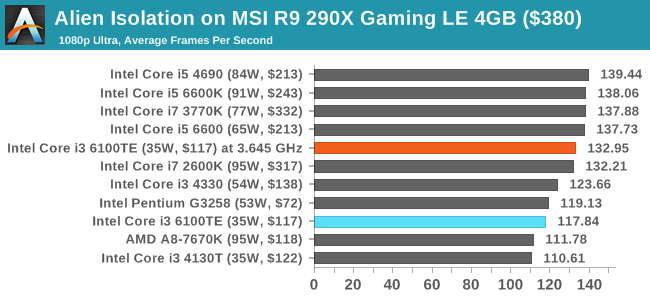
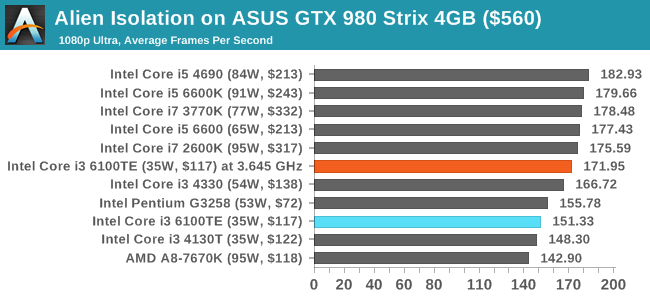
Total War: Attila
The Total War franchise moves on to Attila, another The Creative Assembly development, and is a stand-alone strategy title set in 395AD where the main story line lets the gamer take control of the leader of the Huns in order to conquer parts of the world. Graphically the game can render hundreds/thousands of units on screen at once, all with their individual actions and can put some of the big cards to task.
For low end graphics, we test at 720p with performance settings, recording the average frame rate. With mid and high range graphics, we test at 1080p with the quality setting. In both circumstances, unlimited video memory is enabled and the in-game scripted benchmark is used.
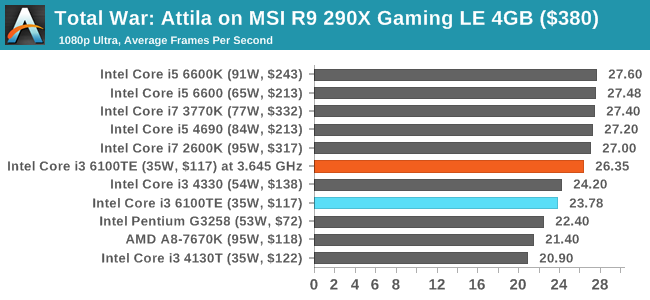

Grand Theft Auto V
The highly anticipated iteration of the Grand Theft Auto franchise finally hit the shelves on April 14th 2015, with both AMD and NVIDIA in tow to help optimize the title. GTA doesn’t provide graphical presets, but opens up the options to users and extends the boundaries by pushing even the hardest systems to the limit using Rockstar’s Advanced Game Engine. Whether the user is flying high in the mountains with long draw distances or dealing with assorted trash in the city, when cranked up to maximum it creates stunning visuals but hard work for both the CPU and the GPU.
For our test we have scripted a version of the in-game benchmark, relying only on the final part which combines a flight scene along with an in-city drive-by followed by a tanker explosion. For low end systems we test at 720p on the lowest settings, whereas mid and high end graphics play at 1080p with very high settings across the board. We record both the average frame rate and the percentage of frames under 60 FPS (16.6ms).

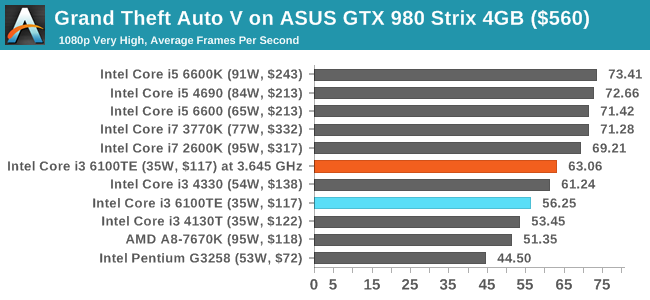
GRID: Autosport
No graphics tests are complete without some input from Codemasters and the EGO engine, which means for this round of testing we point towards GRID: Autosport, the next iteration in the GRID and racing genre. As with our previous racing testing, each update to the engine aims to add in effects, reflections, detail and realism, with Codemasters making ‘authenticity’ a main focal point for this version.
GRID’s benchmark mode is very flexible, and as a result we created a test race using a shortened version of the Red Bull Ring with twelve cars doing two laps. The car is focus starts last and is quite fast, but usually finishes second or third. For low end graphics we test at 1080p medium settings, whereas mid and high end graphics get the full 1080p maximum. Both the average and minimum frame rates are recorded.
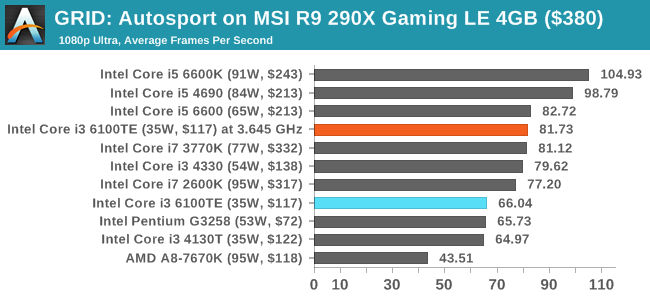
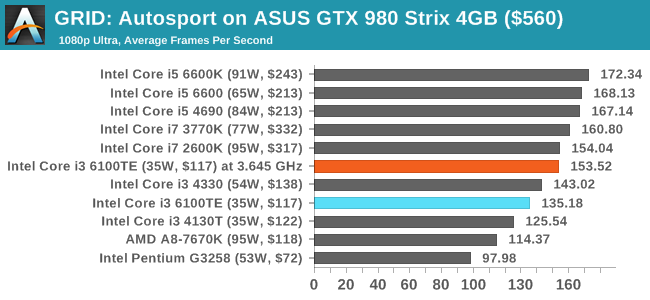
Middle-Earth: Shadow of Mordor
The final title in our testing is another battle of system performance with the open world action-adventure title, Shadow of Mordor. Produced by Monolith using the LithTech Jupiter EX engine and numerous detail add-ons, SoM goes for detail and complexity to a large extent, despite having to be cut down from the original plans. The main story itself was written by the same writer as Red Dead Redemption, and it received Zero Punctuation’s Game of The Year in 2014.
For testing purposes, SoM gives a dynamic screen resolution setting, allowing us to render at high resolutions that are then scaled down to the monitor. As a result, we get several tests using the in-game benchmark. For low end graphics we examine at 720p with low settings, whereas mid and high end graphics get 1080p Ultra. The top graphics test is also redone at 3840x2160, also with Ultra settings, and we also test two cards at 4K where possible.
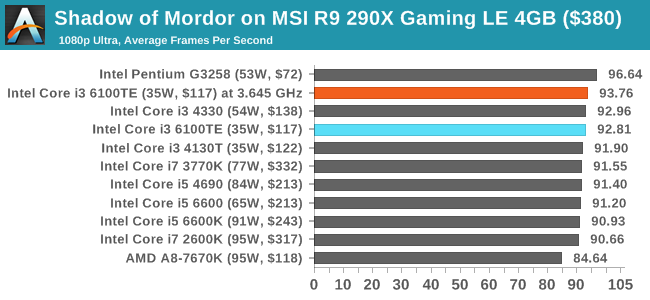
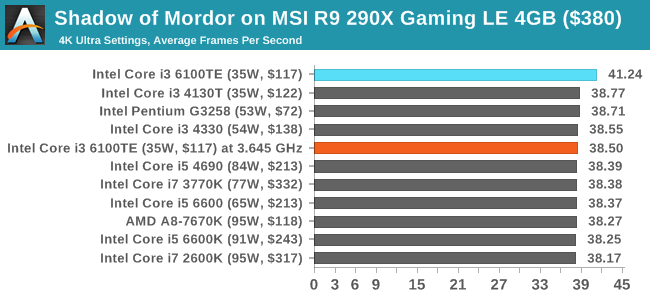

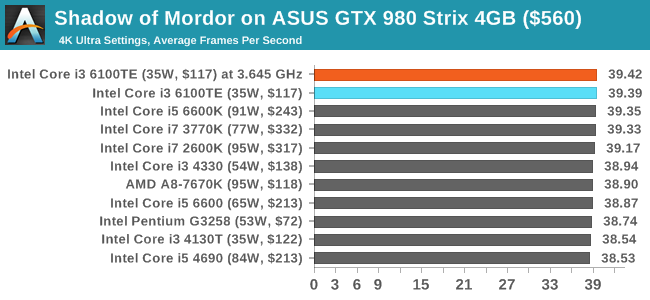















62 Comments
View All Comments
nathanddrews - Thursday, March 17, 2016 - link
Predicating the value of i3 overclocking as a whole on the 6100TE is absurd, don't you think? The 35% OC of the 6100TE is still slower than the base clock speed of the vanilla 6100 (3.7GHz), which when OCed over 4.2GHz offers a tremendous value. For the same price - why on earth would you buy the much slower 35W variant if your goal is overclocking?http://ark.intel.com/compare/90729,88181
From the standpoint of motherboard/BIOS SKYOC availability alone I would agree that the case is now somewhat moot, but I think the case that has already been made months ago by DigitalFoundry and others is that the SKYOC i3 (normal i3 CPUs that you can buy) makes a very strong value. It's a shame that mobo vendors caved so quickly.
dualsmp - Thursday, March 17, 2016 - link
I suspect politics is a work here. Also, the conclusion would be more clear cut with the 6100 rather than a bit nebulous with the 6100TE.Remember how fast Intel shutdown overclocking after the Clarkdale i3? When the Clarkdale i3 was overclocked it was nipping at the heels of Intel's more expensive parts at the time. The Clarkdale i3 offered too much value for the money when overclocked, so Intel had to shut it down.
ImSpartacus - Thursday, March 17, 2016 - link
You're probably right about the politics. It's a shame, but Anandtech is probably under Intel's finger.alistair.brogan - Thursday, March 17, 2016 - link
Is there hope for an AMD Zen dual core that will overclock? That's all I'd recommend for people :)ImSpartacus - Friday, March 18, 2016 - link
If zen is only 40% better ipc than excavator, then it won't be leading Intel and amd will still need high clocks compete. So I would bet that the stock zen parts might be using up a fair bit of that overclocking headroom.alistair.brogan - Thursday, March 17, 2016 - link
I think a properly overclockable i3 would hit 4.5ghz, just like an i5 can, so imagine the results in that case. It wouldn't "maybe" be worth it, it would absolutely by awesome. Which is why Intel doesn't allow it..... don't want people buying 4.5ghz i3's and saying good bye to the expensive i5sdragosmp - Thursday, March 17, 2016 - link
Thanks for the review, it's a good reference point.I thought at some point the lowest end Xeon v5 (4C/8T) was quite a bit cheaper than the 6700K and much more available. If that could be OCed, and I think some motherboards like Gigabyte's Cxxx say they could, that would have been the fastest CPU while keeping some money in the pocket.
Agreed with getting older and putting a higher value on our time, but if my kid decides to leave me alone for a while I still like to tinker with OCing
Samus - Friday, March 18, 2016 - link
It's true Xeon's are usually priced between the i-series and i-series k equivalents (there are i5 and i7 based Xeon's) so it would be cheaper than a "k" part while giving you ECC and full vPro support, not to mention Xeon's appear to have soldered heatspreaders when starting with Ivy Bridge, everything but Xeon's were shipped with pretty subpar TIM/paste. That only slightly improved with Devils Canyon...they still weren't fused lid-to-die like a Xeon.There are a few theories why Intel uses solder on Xeon CPU's. One is obviously temperature and 24/7 consistency. The most plausible reason, though, is the weight and pressure of server cooling solutions (compared to most OEM PC coolers and water blocks. I weighed a tiny 1U Xeon cooler once. This thing was like 20mm tall, and it still weighed 870 grams. That's 2 lbs! Pure block of copper fins. Tightened down to 25Nm and exposed to the pressure, vibration and temperatures of a 1U environment for years, you can take a guess why Intel makes the Xeon lids more durable.
extide - Thursday, March 17, 2016 - link
Please do that future piece, anyone who is seriously considering doing this will definitely not be sing the T or TE series chips, and as you mentioned you can't even really get them in the retail market. I would really like to see what a 4.4-4.6Ghz i3 can do.LostWander - Thursday, March 17, 2016 - link
The idea is to show how close to i5 performance you can get while paying the price of an i3. Although it would be interesting to see how well the i5 overclocks too so we can see how close to K performance we can get for a non-k price.